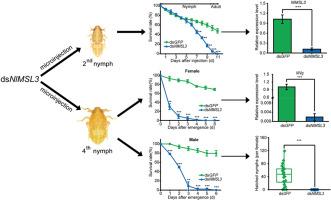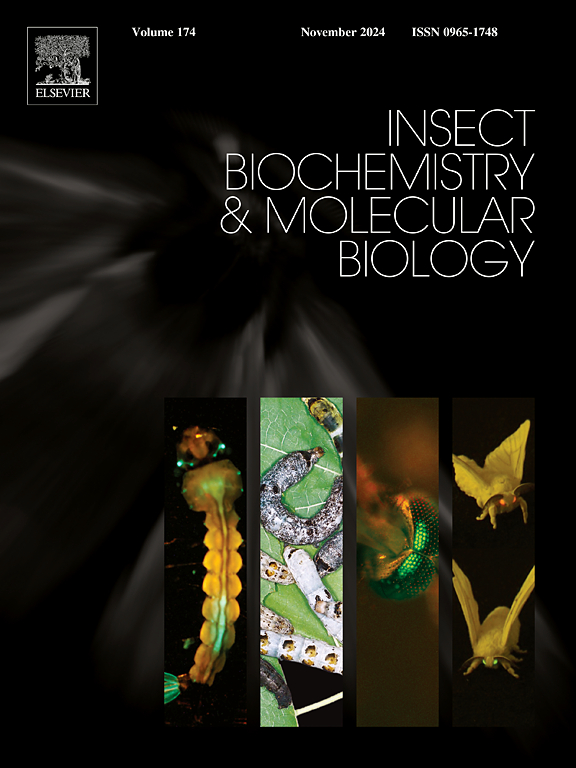雄性特异性致死-3 基因对水稻褐飞虱的生存和繁殖至关重要
IF 3.2
2区 农林科学
Q2 BIOCHEMISTRY & MOLECULAR BIOLOGY
引用次数: 0
摘要
雄性特异性致死-3(MSL3)是黑腹果蝇体内剂量补偿复合物的一个组成部分,它的突变会导致雄性特异性致死。然而,MSL3在半翅目昆虫中的功能仍不清楚。本研究调查了 MSL3 同源物在水稻主要害虫褐飞虱(Nilaparvata lugens)中的作用。我们克隆并鉴定了 N. lugens 的 NlMSL3 基因,该基因长 1467bp,编码 488 个氨基酸的蛋白质。系统进化分析表明,MSL3在昆虫各目中都是保守的,其中色环结构域的保守性很高。定量实时聚合酶链反应表明,NlMSL3在雌雄昆虫的发育过程中表达水平不同,其中在睾丸中的表达量最高。RNA 干扰介导的 NlMSL3 在 N. lugens 中的敲除导致后期若虫和成虫的死亡率显著高于对照组。在雌虫中,NlMSL3基因敲除会损害摄食行为,导致体重下降、蜜露排泄明显减少、腹部扁平、卵黄素表达减少以及卵巢发育缺陷。当dsNlMSL3处理的雄性与对照组雌性交配时,所产卵的数量与对照组雄性交配的雌性所产卵的数量相似;但是,前者所产卵没有一个孵化成若虫。这些结果突显了 NlMSL3 在卢格氏蛱蝶的发育和繁殖中的关键作用。本文章由计算机程序翻译,如有差异,请以英文原文为准。

Male-specific lethal-3 gene is critical for survival and fecundity in rice brown planthopper, Nilaparvata lugens
Male-specific lethal-3 (MSL3) is a component of the dosage compensation complex in Drosophila melanogaster, where its mutation leads to male-specific lethality. However, the function of MSL3 in hemipteran insects remains unclear. This study investigated the role of the MSL3 homolog in a major rice pest, the brown planthopper (Nilaparvata lugens). We cloned and characterized the gene NlMSL3 from N. lugens, which is 1467-bp long and encodes a protein of 488 amino acids. Phylogenetic analysis revealed that MSL3 is conserved across various insect orders, with high conservation in the chromo-barrel domain. Quantitative real-time polymerase chain reaction indicated differential expression levels of NlMSL3 between male and female insects during development, with the highest expression in the testes. RNA interference-mediated knockdown of NlMSL3 in N. lugens resulted in significant mortality in later instar nymphs and adults compared with the control group. In females, NlMSL3 knockdown impaired feeding behavior, leading to decreased body weight, notably reduced honeydew excretion, flat abdomens, decreased vitellogenin expression, and defective ovarian development. When dsNlMSL3-treated males were mated with control females, the number of eggs laid was similar to that laid by the females mated with control males; however, none of the eggs laid by the former hatched into nymphs. These results highlight the crucial role of NlMSL3 in the development and fecundity of N. lugens.
求助全文
通过发布文献求助,成功后即可免费获取论文全文。
去求助
来源期刊
CiteScore
7.40
自引率
5.30%
发文量
105
审稿时长
40 days
期刊介绍:
This international journal publishes original contributions and mini-reviews in the fields of insect biochemistry and insect molecular biology. Main areas of interest are neurochemistry, hormone and pheromone biochemistry, enzymes and metabolism, hormone action and gene regulation, gene characterization and structure, pharmacology, immunology and cell and tissue culture. Papers on the biochemistry and molecular biology of other groups of arthropods are published if of general interest to the readership. Technique papers will be considered for publication if they significantly advance the field of insect biochemistry and molecular biology in the opinion of the Editors and Editorial Board.

 求助内容:
求助内容: 应助结果提醒方式:
应助结果提醒方式:


